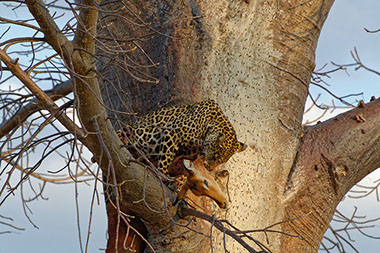+256 760 038002
info@visitafrica.site
Leopards in Africa
Scientific Name:
Panthera pardus
Weight:
17 to 65 kilograms (37 to 143 pounds)
Size:
1.6 to 2.3 meters in length (5 to 7.5 feet) About 60 to 70 centimeters in height (2 to 2.5 feet)
Life span:
Average 10 to 12 years in the wild. Up to 23 years in captivity.
Diet:
Carnivorous
African Leopards
What is an African Leopard?
The African leopard is the nominate subspecies of the leopard, native to many countries in Africa. It is widely distributed in most of sub-Saharan Africa, but the historical range has been fragmented in the course of habitat conversion.
These large carnivores are powerfully built with long bodies, relatively short legs, and a broad head. There are nine subspecies and are distinguished by the unique characteristics of their coats, which range from tawny or light yellow in warm, dry habitats to reddish-orange in dense forests. Their coat is covered in dark, irregular spots called rosettes. These spots are circular in east African leopards, but square in southern African leopards.
Most leopards are light coloured with distinctive dark spots that are called rosettes, because they resemble the shape of a rose. Black leopards, which appear to be almost solid in colour because their spots are hard to distinguish, are commonly called black panthers.
menu

380x254.jpg?crc=210200418)
Where do African Leopards Live?
African leopards inhabit a wide range of habitats within Africa, from mountainous forests to grasslands and Savannahs, excluding only extremely sandy desert. It is most at risk in areas of semi-desert, where scarce resources often result in conflict with nomadic farmers and their livestock.It used to occur in most of sub-Saharan Africa, occupying both rainforest and arid desert habitats. It lived in all habitats with annual rainfall above 50 mm (2.0 in), and can penetrate areas with less than this amount of rainfall along river courses. It ranges up to 5,700 m (18,700 ft), has been sighted on high slopes of the Rwenzori and Virunga volcanoes, and observed when drinking thermal water 37 °C (99 °F) in the Virunga National Park.
It appears to be successful at adapting to altered natural habitat and settled environments in the absence of intense persecution. It has often been recorded close to major cities. But already in the 1980s, it has become rare throughout much of West Africa. Now, it remains patchily distributed within historical limits. During surveys in 2013, it was recorded in Gbarpolu County and Bong County in Upper Guinean forests of Liberia.
Leopards are rare in northern Africa. A relict population persists in the Atlas Mountains of Morocco, in forest and mountain steppe in elevations of 300 to 2,500 m (980 to 8,200 ft), where the climate is temperate to cold
What are the Behaviours of African Leopards?
African Leopards are generally most active between sunset and sunrise, and kill more prey at this time. In Kruger National Park in South Africa, Maasai Mara in Kenya, Serengeti and Ngorongoro in Tanzania and Queen Elizabeth National Park in Uganda, male leopards and female leopards with cubs were more active at night than solitary females. The highest rates of daytime activity were recorded for leopards using thorn thickets during the wet season, when impala also used them.
The leopard has an exceptional ability to adapt to changes in prey availability, and has a very broad diet. Small prey are taken where large ungulates are less common. The known prey of leopards ranges from dung beetles to adult elands, which can reach 900 kg (2,000 lb). In sub-Saharan Africa, at least 92 prey species have been documented in leopard scat, including rodents, birds, small and large antelopes, hyraxes, hares, and arthropods. They generally focus their hunting activity on locally abundant medium-sized ungulates in the 20 to 80 kg (44 to 176 lb) range, while opportunistically taking other prey
380x254.jpg?crc=324615)
What do African Leopards eat?
African Leopards prey mostly on impala, both adult and young, and catch some Thomson's gazelles in the dry season. Occasionally, they successfully hunt warthog, dik-dik, reedbuck, duiker, steenbok, wildebeest and topi calves, jackal, Cape hare, guineafowl and starling. They are usually less successful in hunting zebras, Coke's hartebeests, giraffes, mongooses, genets, hyraxes and small birds. Scavenging from the carcasses of large animals make up a small proportion of their food. In tropical rainforest in Central Africa, their diet consists of duikers and primates. Some individual leopards have shown a strong preference for pangolins and porcupines.

8 Interesting Facts about African Leopards
- Because of its adapted retinas, leopards can see seven times better in the dark than humans.
- Black leopards are seen infrequently in parts of Africa. The difference in colour is not indicative of a separate sub-species, but rather dominance of the dark-coloured pigment melanin in the skin, and is the opposite of albinism. Talking about the leopard’s physical appearance, there is a considerable variation in the coat colour and rosette patterns depending on the location of the animal. In East Africa, the leopard’s rosettes are more circular but tend to be more square-shaped in southern Africa. The yellow coat is paler in the desert regions.
- Portrayed as the most seldom seen, leopards are actually the most widely distributed African big cat. They can be found in a variety of habitats ranging from desert country to equatorial forests, high mountains to coasts. Few can also be spotted on the outskirts of large cities like Pretoria, Harare and Nairobi.
- Leopards are spectacular hunters! Not only are they quite fast and can run up to 58km/h, but are also famous for their incredible agility and strength to climb trees while dragging a kill that is sometimes heavier than their body weight.
- Leopards survive on a variety of prey. For example, in some regions of southern Africa, 80% of their diet comprises of rock hyrax. In the Kalahari Desert, they are known to favour bat-eared fox. Leopards also eat fish, insects, reptiles, birds, rodents, porcupines, mongoose, baboons, genets and monkeys.
- How do you tell the difference between a leopard, cheetah and jaguar? Look at the spots! Leopards have rosette spots on the body and solid black spots on the legs, head and sides. There are also no black facial stripes, unlike cheetahs. Compared to jaguars, leopards do not have smaller spots inside the polygonal rosettes.
- Female leopards protect their young cubs by hiding them in lairs. Lairs can be found in a variety of places, including outcrops of granite boulders, old aardvark holes made in the side of termite mounds, or dense thickets at the bottom of deep galleys. These hiding places serve as a refuge for when the mother is away, as lions and hyenas pose a significant threat to the cubs. The mother changes the lair every few days to eliminate the chances of discovery by other predators.
- Leopards make a variety of sounds, including a territorial hoarse, raspy cough, a contented purr, and a threatening hiss.
Visit Africa is an African tourism brand of Architect Tourism SMC, that profiles every tourist destination, in every country, in Africa; Destinations, How to get there, Attractions, Things to do, How to get around, itinerary pricing and Where to stay, for an adventurous breathtaking and thrilling experience of tourism of Africa.
Visit Africa
Destinations
We are Social!
Search this Site!
About Africa
Visit Africa
Visit Uganda
Tanzania
Visit Kenya
Visit Egypt
Cities in Africa
Visit Morocco
Tour Itineraries



Visit South Africa
Visit Namibia
Visit Zimbabwe
Wildlife in Africa
Visit Africa Copyright © 2019 - Visit Africa is a Tourism Brand of Architect Tourism SMC Limited.
Architect Tourism SMC is an African tourism company, crafted to inspire and enable a breathtaking beautiful experience of Africa. Visit Africa is one of Architect Tourism SMC tourism brands. Visit Africa is inspired to craft innovative, fun and breathtaking tourism events, trips, excursions, getaways, safari, vacations, holiday, and tours experiences.
Vision: To inspire, craft, and enable a breathtaking beautiful experience of Africa.
Our Values: African, Oneness, Integrity, Client focused, Conservation focused, Innovative, Excellence, Simplicity.
Company Registration Number: 80020002986484
Company Tax ID: 1018106912
